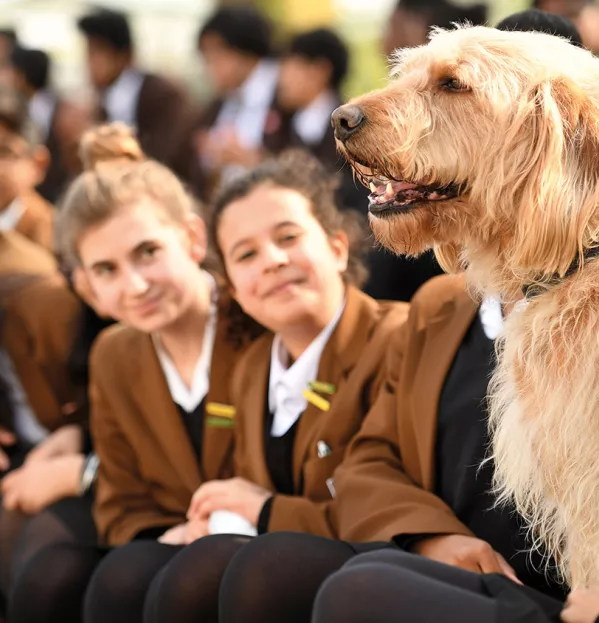Four-legged friends show headteachers just who’s top dog

“His role?”
Térèse Wilmot, principal of Beal High School, pauses to think about exactly why she is standing on the school field holding the lead of a 2ft-high golden Labradoodle.
It is a Labradoodle that is being mobbed by adoring students.
“His role is to bring joy,” she explains.
Ms Wilmot is serious about this. Jasper - aka Vice-Principal Jasper, aka Jaspreet, aka Campus - has as many benefits as he has nicknames. But his prime job is simply to be himself: the school dog.
Beal High in Ilford, Essex, is one of a growing number of schools that have found having a dog around the place has many advantages.
In some cases dogs visit schools as part of a structured reading programme, or they may be put to work in a therapeutic role.
In Jasper’s case, the plan was simply for his owner - Kathryn Burns, the managing director of the Beacon Academy Trust, which oversees the school - to bring him in on Fridays to see if he could help.
Since then, six-year-old Jasper (pictured, above) has been involved in reading, modelling for art classes, visiting the children in the autistic unit and cheering up students as they go home. He has also helped shy children to make friends, and persuaded moody teenagers to drop their front.
Jasper’s wider role may not have been planned, but he has been by Ms Wilmot’s side in her determination to strengthen the school as a community, and has ended up being “one of the most significant parts” of that work.
Old dogs, new tricks
The Kennel Club estimates that there are now more than 900 schools that have dogs visiting just as “reading volunteers”. There are 12 separate charities offering schools visits from dogs, which are helped by the club’s Bark and Read Foundation.
Pets as Therapy (PAT) - the largest of these charities - currently has 800 schools on its books, with the number growing at a rate of around 150 to 200 schools a year. Cate Archer, a former special needs teacher, volunteers with PAT, taking her pet, Doug the Pug, to visit two schools and a pupil referral unit each week.
“Children read to Doug because he doesn’t correct them, or interrupt,” says Ms Archer. “By reading out loud, they become more confident, they contribute more to school life, they become more social in the playground.”
Dogs working with PAT are not trained by the charity, but they are assessed for their suitability. However, some charities do own and train dogs, and have professional handlers rather than volunteers.
Dogs for Good - based in Banbury, Oxfordshire - trains 50 dogs a year. It started as an assistance dog charity working with adults with physical disabilities and children with autism, but has now expanded its work into other areas, including schools.
“Children with a physical disability may have to do physiotherapy, which can be a bit boring,” explains Hayley Stimpson, community dog manager at Dogs for Good.
But, she adds, if a dog is put into the mix, it suddenly becomes fun. “If a child has to stretch, for example, they can see who can stretch furthest - the child or the dog.”
Unlike the reading volunteer dogs, these school dogs are working dogs, following a long line of herders, rescue dogs and guide dogs. As schools are not a natural environment for them, the handlers must ensure the dogs are given time to run and rest during the day.
Tracey Berridge, who founded the Dogs Helping Kids charity, is concerned that the welfare of dogs remains a priority as the number of dogs in schools continues to rise.
“I want dogs working in schools - it’s a really good thing,” she says. “But I want the welfare of the dog to be at the core of it. But sometimes I get emails saying, ‘I want a dog next week’ - as if someone is ordering a computer.
“I don’t think they are doing it to be horrible; they are just swept up in the fact that it’s an amazing thing - this bond between dogs and children. But they are not thinking enough about it.”
The Department for Education does not have any specific guidance for dogs in schools. But it does say that schools are expected to carry out a health and safety risk assessment in advance of a visit.
One issue that can arise for those schools that want to work with dogs is how to deal with people who are scared of the animals.
Jasper is kept on a lead as he walks around Beal High. But Ms Wilmot is careful to warn staff members who are not so keen on him that he is approaching before office doors are opened.
“I thought having a school dog was a joke at first,” says Shelly Jackson, the school manager, who admits that canines make her nervous. “Then I was horrified. I thought I wouldn’t be free to walk around.”
But, slowly, she got used to seeing Jasper, then stroking him, then feeding him treats. “I’m still frightened of dogs,” she says. But I love him.”
You need a Tes subscription to read this article
Subscribe now to read this article and get other subscriber-only content:
- Unlimited access to all Tes magazine content
- Exclusive subscriber-only stories
- Award-winning email newsletters
Already a subscriber? Log in
You need a subscription to read this article
Subscribe now to read this article and get other subscriber-only content, including:
- Unlimited access to all Tes magazine content
- Exclusive subscriber-only stories
- Award-winning email newsletters